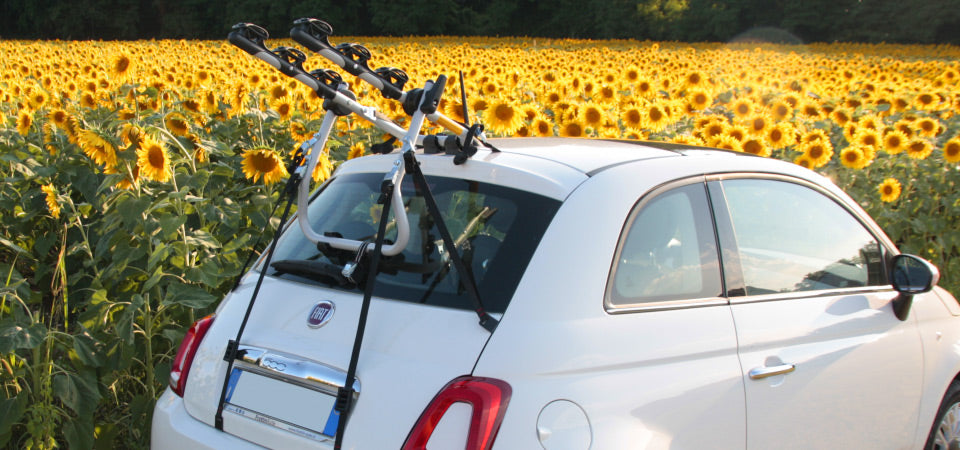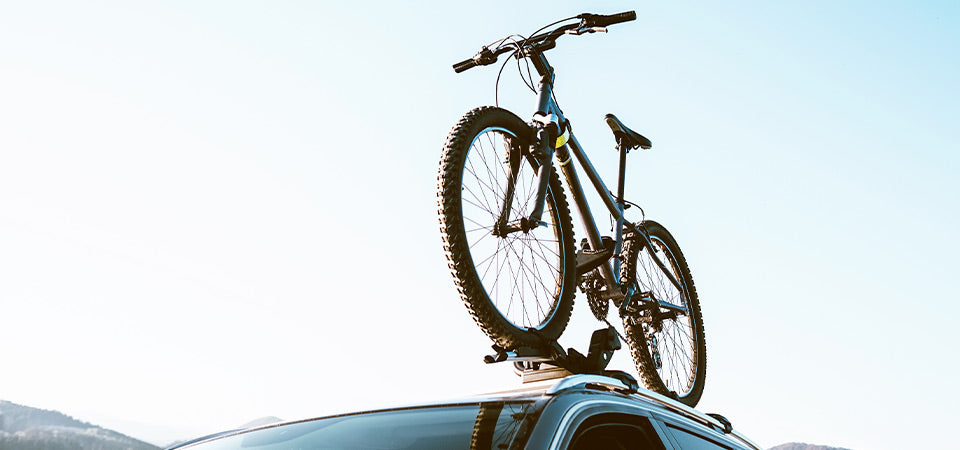Cycling is an increasingly popular way to explore your surroundings whether on local trails close to home or away on holiday. Depending on where you live, getting your bikes to a low traffic leisure trail for a family bike ride with the kids, or to the mountain bike trails, can involve a fair distance to travel. If going away on holiday, the car, or caravan, can be already packed with all your other holiday gear, so a cycle carrier is the perfect solution to taking your bikes on holiday or for a day out exploring.
There are a range of types and styles of cycle carrier, each one with their advantages and disadvantages - so which type is the best car bike rack for you?
Tailgate Rear Mounted Bike Racks

Tailgate cycle carrying racks that strap onto the boot lid are the most common types of bike carrier - the rack is complete with no other fittings needed to mount it to the rear of the car and the principle is straightforward. Simply strap the bike rack to the back of the car, then hang the bikes in place, secured with straps.
There are a range of styles of this type of carrier, and prices can range from some of the lowest priced racks to more advanced models. The most basic, cheap bike carriers generally consist of a metal tubular frame with numerous hinges and straps - most offer some kind of folding facility but each time you use the carrier it needs adjusting and setting up for your car, if it has been folded away. These bike carriers have a near infinite amount of adjustment in order to fit different types of vehicles but can take some trial and error to set up, especially for the first time, to get the best fit for your car.
More advanced carriers such as the Saris Bones bike racks are manufactured in composite materials and are carefully designed to fit most cars without lots of adjustment, or trial-and-error. Bike racks of this style are designed to also minimise the distance that the bikes are held away from the vehicle whilst still maintaining adequate clearance, to hold the bikes securely without excessive movement. These designs also allow for wider padding at points of contact with the vehicle.
The appeal of this type of carrier is that no specialised mountings are needed, so there is no need for a roof rack or towbar, and the near-universal nature of the carrier means that it can be swapped between most vehicles. However - if your bikes obscure any part of the vehicle's rear lights and/or registration plate, it will be necessary to mount an auxiliary lighting board - which means that a towbar-style socket will be needed even if your car doesn't have a towbar.
Apart from some high-end models, most boot mounted racks hand the bikes from the crossbar - mounting non-standard frames or women's / step-through frames can be difficult or require a crossbar adaptor bar
The specific type of tailgate cycle carrier that you choose may depend on how often you plan on using the carrier - a low cost carrier may be ideal for occasional use with one or two bikes, when looking for a 3-bike carrier or larger capacity, for regular use, the advantages of some of the premium range become key.
Pros:
- Universal (or almost-universal) fitting
- Price range begins with low cost models.
- No specialist mountings needed*
Cons:
- Some movement of the rack and bikes even on high end models
- Care required to make sure mounting points do not rub on bodywork
- Not possible to open the boot with bikes attached
- Adaptor may be required for step-through or Y-frame bikes
Towbar Mounted Bike Racks

If you already have a towbar, a towbar mounted cycle carrier is the natural choice when it comes to choosing a bike rack for your car. Bike racks which mount to the towing bar are quick and easy to fit without the need to adjust straps, and without contact with the bodywork, although some basic models do feature a reinforcing top strap that hooks over the top of the boot lid.
If you have a towbar with a traditional bolt-on towball, with 2 mounting bolts, there are a few models which mount to a plate that is sandwiched between the towbar and towball, leaving the towball clear for use, meaning that with this type of carrier you can also tow whilst carrying cycles, although you should be aware of the noseweight (downward force) and remember that the load on the towbar will be both the weight of the bikes being carried, PLUS the noseweight of the trailer or caravan. Clearance for turning or reversing should also be carefully checked before setting off. This type of towbar rack can't be used with a swan-neck or detachable towbar.
As swan neck and detachable towbars have become common, most towbar fitting cycle carriers attach directly to the towball, making them suitable for all types of UK and European towballs but also meaning that you cannot tow whilst using the cycle carrier.
Most towbar mounted carriers are of a platform type design, with rails that hold the cycle wheels securely and an arm that grips the bike frame, holding the bikes firmly in place. 2-bike, 3-bike and 4-bike cycle carriers of this style are common. With the rack attached to the towball, the bikes are easy to load onto the carrier without the need to lift them high. Most models feature a tilt system of some form, allowing the boot lid or tailgate to be lifted for access into the rear of the car with the bike carrier attached. This style of carrier often includes an integrated number plate holder and rear lights that plug into the towbar socket, maning no need to hang a lighting board onto the bikes.
Because this type of rack is so convenient and secure, many people wishing to make regular use of a cycle carrier choose to have a towbar fitted specifically to carry bicycles.
The strength of the towbar mounting means that you can find cycle carriers for electric bikes in this style
Pros:
- Easy to fit and to use
- Bikes are held securely
- Minimal lifting involved to attach the bikes
- Often suitable for electric bikes
Cons:
- Cycle carriers need a towbar fitted to the car
- Initial cost of cycle carrier plus towbar is higher
- Usually cannot tow whilst carrying bikes
Roof Bar Cycle Carriers

A popular way of carrying cycles is on the car roof, with roof mounted bike racks. Carrying cycles on the roof means that the tailgate is completely unobstructed, giving full access to the boot. If you plan to tow a caravan or trailer too, with a roof bike carrier there is nothing to hinder connecting the trailer.
A roof bar cycle carrier does require a set of roof bars to be fitted to the car and for most universal rood cycle carriers, the square type of roof bar is preferable - the carrier clamping around the bars. If you have areodynamic bars such as the Thule WingBar system you may be restricted to a cycle carrier from the same manufacturer, designed to fit that style of bars. Roof bars are generally cheaper than a towbar, so can be a lower cost outlay if you have neither on your vehicle. There is also no need for any additional lighting to be fitted to carry bikes on the roof.
Most roof bike carriers come singly, as carriers for one bike and range from a basic block to hold a fork and rear wheel whilst carrying the front wheel inside the car, to models with securely locking arms. Often the lower cost carriers come with a convenience cost, so just as for other styles, you may make the choice dependant on whether you plan for occaional or regular use, and decide the best fit for you accordingly. You can also easily configure to carry one, two or more bikes, within your vehicle's loading limits of course. It's possible to make versatile use of the space by fitting one or two bike racks alongside a half-width roof box, for camping luggage etc.
Its important to remember when using a cycle carrier on the car roof, that the bikes are there, and to know the headroom that you need. It's a not-uncommon and potentially costly error, to turn under a low bridge or into a car park barrier, momentarily forgetting that the bikes are mounted high above.
For heavy bikes, electric bikes, or tall vehicles, a roof cycle carrier may not be the best solution due to the need to lift the bikes high in the air to mount them onto the rack.
For a tandem, because of the bike length, a roof bike carrier for tandems is the only option of the main 3 which carry the bike front-to-rear
Pros:
- Usually a lower cost than a towbar rack
- Fit as many or as few carriers as you need within the vehicle limits
- No need for additional lighting, number plate etc.
Cons:
- Bikes need lifting high abofe the car to fit to the carrier
- Important to remember the need for headroom when carrying bikes
Other Cycle Carrier Options
Less common cycle carriers include spare wheel cycle carriers - designed for use on 4x4 vehicles with a vertical (or near vertical) spare wheel mounted on the rear door. There are also specific cycle carriers for caravans and motorhomes designed to fit to the bodywork and frame of your leisure vehicle.
In-Car Cycle Carriers are also available for larger vehicles such as MPV's and vans, to hold a bicycle upright within the car.
Of course, if your boot is large enough, simply laying the bike down in the boot is also an option - often the front wheel will need removing and care should be taken not to bend or otherwise damage the gears, hanger or scratch the frame with other luggage. If planning a muddy off-road ride don't forget that you will need to put the bike back inside the car if you choose not to use a bike carrier









